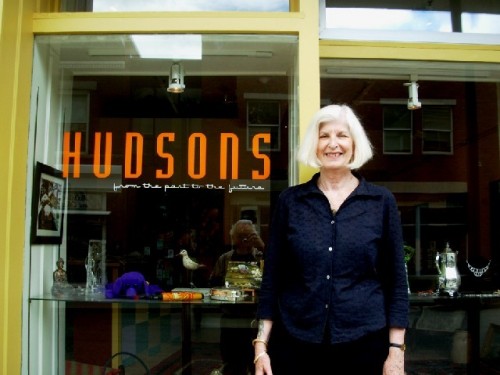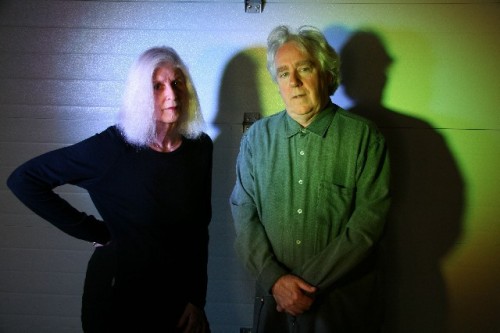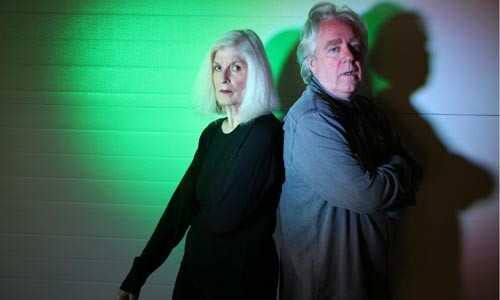Jane Hudson Reflects on Art Education
Former Faculty Member of the School of the Museum of Fine Arts
By: Jane Hudson - Nov 17, 2012
Over the forty-three years of being in the classroom/studio I have come to an understanding of my motivations, those variable impulses, technological desires, interpersonal mysteries and political struggles that brought me to this writing. My own education has been mostly on the ground (after a standard liberal arts degree in English and Art History) learning by doing and following movements in culture and in my personal life that have drawn me to art making and the unique complexity of being an artist and teacher.
I retired from teaching about five years ago.
I began when my parents demanded that I find a job after my first marriage failed.
Those that can, do, and those that can’t, teach.
I had wanted to be a writer, a poet. I was the child of artists. But I didn’t have the guts to throw myself into the thick of the publishing world. I could act too, but Broadway had eluded my mother so I didn’t try. I had a musical gift, I could play and sing. My father was a renown pianist.
My own artistic life was unfocused and frustrated, and I didn't have enough self-confidence to take the risk to make it happen. However, the last thing I wanted to do was teach. And throughout my professional life that old lacuna has haunted me.
I began teaching as a substitute in K-12 classes. I taught history, English, new math, in the general pandemonium of children’s needs.
Finally a place came up in the High School, and I took on a full load teaching literature and composition to teenagers. This was the 60’s and new voices were being heard about the structure of education. I made an effort to bring some of the student-centered approach to the traditional curriculum with some isolated successes. In the end I was offered a position in a more progressive school.
As I moved to that school, in an affluent suburb, I learned about the class system, the way socio-economic strata were articulated within the level system. From AP to A and B and C such that the outcasts (for a multitude of reasons) were lumped together at the bottom. The rest struggled with the demands of success.
These bottom folks were often artists, or druggies, or political radicals, or actors or mutants, and occasionally handicapped kids and pregnant teens.
Something about me understood their need for a voice. Perhaps my own struggles with the 'system' and my own demons rang a familiar note.
So we talked about life. Theirs and mine. Groups formed, individuals stood out. Tests were passed which means they tested me and I tested them around boundaries. It worked.
Toward the end of my public school training ground, I had a profound realization about my own capacity to take orders from others! The administrative and pedagogical framework of the schools was so dependent on the tools of evaluation that the process of teaching and learning became an academic exercise! The engagement and enthusiasm of students for material presented to them in rote form was low. The nuance was shot out of it.
I began living among artists, opening up pathways to performance and video, using old skills in new contexts. The excitement of being part of a ‘new movement’ in an old city took a lot of my attention. I was still working in public school, but began to get close to people from the School of the Museum School in Boston (SMFA aka Museum School).
The opportunity of a lifetime came up. With my partner (now husband) Jeff, we created a video art course of study at the SMFA.
We were among only a few artists working in the new medium, and I had teaching experience. We were hired as a team. The medium was so young that we invited students to invent it with us.
Over night I was transformed from a rebel, raging against the bureaucracy, to a loyal follower of the school’s ethic.
The Museum School student was liberated, self-directed, curious, energized even passionate. The studio, whether open space or highly technical, was the ground from which all grew.
There had been a rebellion at the school in the late '60's when formal pathways to artistic excellence were jettisoned, and a self-governing, rigorously liberal, and laissez-faire administration created an atmosphere of open-ended artistic applications and admixtures of techniques, with authority resting in the hands of students and teachers in mutual discourse.
Even with a minor in Art History, I was really flying by the seat of my pants. Approaching a student painter one day early in my tenure, I began to offer an opinion about her work. She responded sharply to me that I had no business speaking as I was a video artist and wouldn't understand issues of painting. This moment was emblematic to me as I was later to recognize.
First, I knew right away that I needed better grounding in the processes that each medium employed, and so I was as much a student as the rest.
The old model of master and apprentice was out the door. We were all learning from each other, each bringing a particular wedge of experience and skill to the pie.
The Review Board was the secret weapon! This hour and a half encounter with two faculty, one student reviewer and the artist being reviewed provided the context within which work would be discussed, future opportunities revealed, and intentionality clarified. So it was a very personal encounter. The student's needs and capacities brought into relief. And credit granted (or not)!
I might work with a ceramist or a performance artist or a photographer. We all had to learn to speak to the medium, but also consider the ways in which the artist might combine or redefine formal approaches. We all brought what we knew to bear but also broadened our own ideas, finding clues to our own processes in the mix.
I guess having a lack of hierarchy, or at least a diminishment of the most glaring aspects of power politics, allowed for some pretty outrageous experiments as well as devotional practice.
I have been reluctant to reflect on my years teaching as they are so much about the living of them. Again, one of the little miracles of the SMFA was it's focus on process. This is the developmental ground, the hot house of artistic growth and the cutting floor for those who don't engage.
I am skeptical about histories as they always seem to be born of a formal imperative, the historian's bias. Canning such an organic movement into a pedagogy leaves so much unsaid about the chaotic profusion of possibilities that must remain unused or discarded or ultimately adopted. Initial motivations coming from previous training or popular misapprehensions often evolve to look nothing like the original. Leaving room for this growth, no matter how helter-skelter, and having faith that it will lead to a real and desirable production, is key to teaching artists.
Of course, times change and what once was crucial to the zeitgeist has become blind to itself and to emerging necessities. The '80's was the time of New Wave and AIDS, the crash of the party, bad economy, and exhaustion of the permissive, and the rise of Feminism. At the school there were signs of European Post-Modernist critique, the dissolution of the meta narratives of Western hegemony. The work of art no longer sat in benign isolation, but carried in its patina the remnants of social currents, psychological furrows, familial legacies.
This is to say that the formalist writings of Clement Greenberg and Michael Fried were the usual fodder upon which artist cognoscenti nibbled. Having that world based so much on the genius of the individual artist (a paradigm close to the heart of the school) being burned out by politically incendiary ideas was wrenching for many.
The faculty had to back and fill, scrounging for texts, following their noses to do the work that happens in MFA programs. These were mostly all working artists. Only a very few with advanced degrees. These were professionals. So to take on the work of academic research was very demanding. Some were more assiduous than others.
I had had a background in literature, and so dealing with agitprop philosophy was not unfamiliar ground. Also, based in the new technologies I was somewhat liberated from the weight of the traditions of art making. I embraced the new critique as a route around formalism's doctrines. It was a beautiful revolution, an intervention into yet another institution of Western, male, formalist domination. But, of course, I had the background against which to rebel.
Being a woman in a man's world (both art and technology) was a familiar challenge. The men in my life, all artists, had pursued their talents with focus and the support of the women around them, including myself. That was, after all, the model for the artist. I learned how to be that support, and, by osmosis, learned many artistic applications that I was later to employ in both my work and teaching. But, I had to deal with pressure from a growing number of women to offer a rationale for relationships with men. Oy! My 'nurturing' approach to my students grew out of that old role, and so I had to find a balance, a way to be effective without yielding my rightful place as an artist and authority.
About the same time, and over the next few years, the school began to pay a lot of attention to the MFA Program. In concert with Tufts University, the candidate completed courses offered by both schools while maintaining a critique schedule with faculty from the Museum School. The degree was based on a Thesis exhibition, completion of designated academic courses, and seminars conducted by SMFA faculty of which I was one.
Much of the school proceeded apace, with undergraduates still quite free to pursue their inclinations. Grad students on the other hand, many having come from university art departments, had to be reduced to elemental standards, and brought to themselves, while as well taking on the climate of theoretical discourse. My second year Grad Seminar was a cauldron of repurposing.
I found that the Grads were quite needy, for reassurance about their practice and kudos for their intellectual prowess. This led to many long critiques , part shrink sessions and part debate. There was lots of pride in being a smartipants! What I missed as time went on (I worked in the Grad Program for 20 plus years) was the devotional approach to making work. Clearly some artists were more skilled and disciplined than others, and everyone made a huge effort for the Thesis Show. But more and more the work reflected the larger socio-political climate and less and less seemed to be about formal or aesthetic issues. Or at least, not about the ones we knew from the past.
During this time, I was also forced into a steep learning curve moving from analog to digital video. I had developed skills in advanced analog production, and moving to the computer was very awkward. The early versions of digital editing were clunky, arcane, and extremely limiting. My heart was breaking for those losses, the artistic ones of individual vision and beauty as well as the technological ones where I had expertise. Also, institutional politics began to get to me. That old shibboleths of administrative interventions, new structural initiatives and faculty jealousies wore on me.
The dream of openness, real dialog, and autonomy was dissolving into the press for the degree. Process as its own reward had fallen to the demands of the intellectual marketplace.
I am still left with a conundrum where my longing to be an artist is shadowed by my desire for connection, and my love of the dynamic between people. I am not my father who devoted his life to his talent, nor my mother who needed to be in charge as a director but created a family too. I have lived with a surrealist, a formalist and a minimalist. I've produced all kinds of work, and performed as well. What was it I wanted to share with all those kids? Perhaps the chance to find through helping them grow, I might find my own path to growth. But more, the look in their eyes when something takes hold is worth everything.
http://hudsonsart.com




